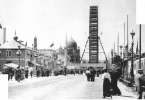The royal and noble families of the 15th and 16th centuries in Europe – an era when the France and the Great Britain both were beware of the Ottoman Empire – did not know much about decorations and the only extra decor they would use were carpets. For instance, Henry VIII of England (1491 – 1547) felt very proud to have hundreds of carpets at the palace during those years.
The actual Turquerie fashion that had repercussions throughout Europe continued its influence between the end of the 17th century until the end of the 18th century. Amongst the items that had contributed to the spread of Turquerie were Turkish delight, water pipe, tobacco pipe, Turkish bathhouses, towel, napkin, quilted turban, headgears, pomegranate, tulip motifs, sherbet (sweet drink) that the Europeans still call “sorbet”, sofa, divan, silver heads clip and belts, pattens, angora wool called “mohair”, miniature portrait making, Nicea ceramics, Ottoman style tent kiosk and fountains, Edirne style artworks, oriental flower motif in silk materials from Bursa, the art of marbling and wrappings. These items of the Ottoman culture that arrived from the exotic and mysterious East had formed a new breeze, curiosity and admiration.
Coffee, tea and spices that were attained from Istanbul, located on the Silk Road, had also tremendously contributed to the Turquerie fashion. The phrase of “Café Turc”, which is Turkish coffee, proves that the Turks had introduced it to Europe, which was still unfamiliar with the consumption of coffee.









Leave a Comment